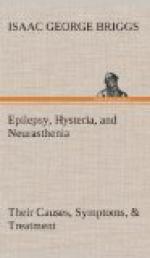You must learn from your doctor and your own experience the prescription, time and dose best suited to your case, and then never miss a dose until you have been free from fits for two years, for the beneficial action of bromide depends on the tissues becoming and remaining “saturated” with the drug. Never give up bromides suddenly after long use, but gradually reduce the dose.
It is just when the disease has been brought under control, that patients consider further doctor’s bills an unnecessary expense, with the result that a little later the fits recur, and a tedious treatment has to be commenced over again.
No value can be placed on any specific for epilepsy until it has been thoroughly tested for some years, and so proved that its effects are permanent, for almost any treatment is of value for a time, possibly through the agency of suggestion.
* * * * *
CHAPTER XX
PATENT MEDICINES
“Men who prescribe purifications
and spells and other illiberal
practices of like kind.”—Hippocrates.
“...Corrupted
By spell and medicines bought of mountebanks.”
“Othello.” Act
I.
Carlyle said the world consisted of “so many million people, mostly fools”; and he was right, for to public credulity alone is due the immense growth of the patent-medicine trade.
It was formerly thought that for each disease, a specific drug could be found, but this idea is exploded. The doctor determines the exact condition of his patient, considers how he best may assist nature or prevent death, and selects suitable drugs. He carefully notes their action and modifies his treatment as required. The use of set prescriptions for set diseases is obsolete; the doctor of to-day treats the patient, not the disease.
A few patent medicines are of limited value; many are made up from prescriptions culled from medical works, and the rest are frauds, like potato starch. The evil lies in charging from three to four hundred times a just price, in ascribing to a medicine which may be good for a certain disorder, a “cure-all” virtue it does not possess, and in inducing ignorant people to take powerful drugs, reckless of results.
Ephemeral patent-medicine businesses, run by charlatans, whose aim is frankly to make money before they are exposed, spring up like mushrooms; and their cunningly worded advertisements meet the eye in the columns of every paper one opens for a few months; then they drop out, to reappear under another name, at another address. These rogues buy a few gross pills from a wholesale druggist, insert a small advertisement, and so lay the foundations of a profitable business.
The lure of the unknown is turned to account. “The discoverer went back to the Heart of Nature—and found many rare herbs used by Native Tribes.” “The “Heart of Nature” was probably a single-room office tucked away down a Fleet Street alley, and analysis proves these medicines contain only common drugs, one “Herbal Remedy” being metallic phosphates.




